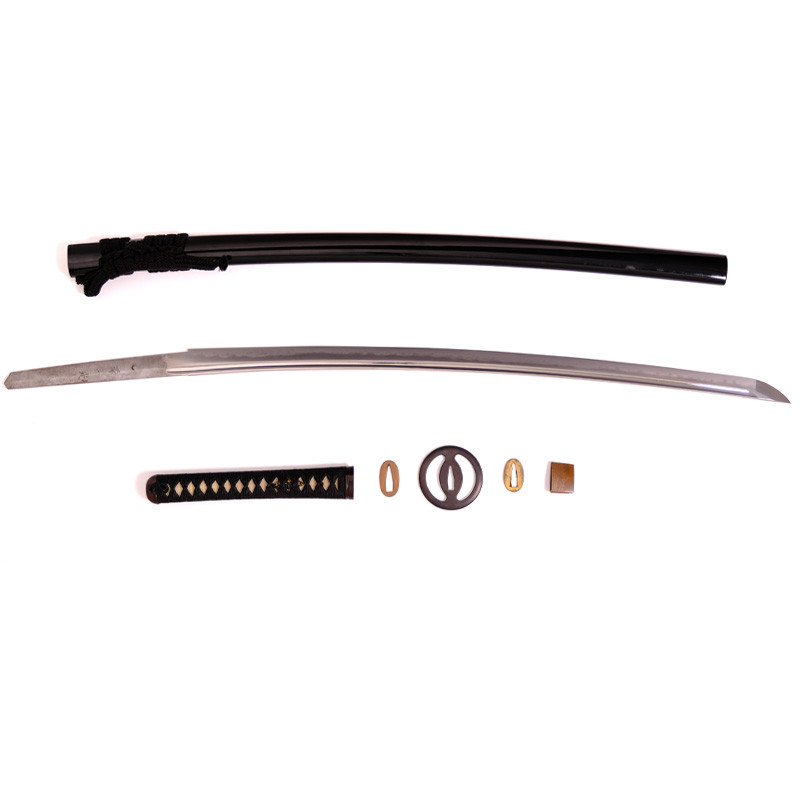














More informations about this product
| Total Weight | 1.214 kg | |
| Weight without Saya | 0.957 kg | |
| Blade Weight | 0.708 kg | |
| Full Blade length (Toshin) | 95.1 cm | |
| Nagasa | 72.7 cm | |
| Nakago Length | 22.5 cm | |
| Sori (curvature) | 2.10 cm | |
| Kissaki Length | 4.35 cm | |
| Moto Haba | 3.32 cm | |
| Saki Haba | 2.40 cm | |
| Moto Kasane | A = 0.56 cm B = 0.45 cm |
|
| Saki Kasane | A = 0.49 cm B = 0.45 cm |
|
| Curvature | Koshi Zori (Curvature on the first third) | |
| Type Kissaki | Ō Kissaki (elongated length) | |
| Blade Structure | Shinogi zukuri (diamond shape) with Bo-hi (grooves) Shinogi Hi (wide) and Kaki Nagashi (across under the habaki). |
|
| Mune | Iori mune (Triangular) | |
| Hamon | Ō Busa Choji Midare very active in Nie (close to a Juka Choji), with significant presence of Yo, Sunagashi and Kinsuji. |
|
| Hada | Ko-Itame | |
| Boshi | Hakikake / Kaen | |
| Nakago | length 22.5cm, Signed 源一光 "Minamoto Kazumitsu" on Omote face and dated 乙丑年二月日 "1985" on Ura face, Futsugata Shape (Classic Shape), 1 Mekugi Ana, Kiri Yasurime, Iriyamagata End (Asymmetrical V-Shape) |
|
| Saya | Length: 80.8cm, Weight: 257 g, Saya Kuroro (glossy black lacquer), with black Sageo cotton. | |
| Tsuka & Tosogu (Tsuba, Menuki, Fuchi Kashira) |
- Tsuka : weight 109g, length 24.5cm, Same white, Hineri Maki braiding in black silk, Menuki with Hanaguruma 花車 pattern, Fuchi-Kashira Musashi 武蔵 with Higo-style rounded Kashira. - Tsuba : Weight 92g, diameter 7.6cm, thickness 0.5cm, fine Maru Gata shaped Tsuba (rounded), in blackened patinated iron. Tsuba sukashi with large openings in the pattern of Namako 海鼠 (Sea cucumbers), considered a refined dish for special occasions, and symbol of luxury. - Habaki : 35g, Gold Copper, Neko Gaki Yujo pattern. - Seppa : 2 copper seppa (4g and 6g). |
|
| Study & Team Review |
Minamoto Kazumitsu 源一光, of his civil name Kamano Hajime 鎌野始, forged during the Showa period (1926-1989) and was a member of the Zen Nihon Tosho Kai 全日本刀匠会. He lived in Minamata 水俣, Kumamoto Prefecture 熊本, Kyushu 九州. Historically, the city of Mimata is a town in the province of Higo and on the border of Satsuma, places full of history, forges and samurai, but also political and religious. This blade is a faithful replica (Utsushi) of the blades from the Kamakura period, in the Bizen Fukuoka Ichimonji tradition. It is often said that these blades are the most magnificent of the Kamakura era. Specifically, because of the wider Monouchi than these predecessors, it is a mid-Hakamakura blade replica. The Ichimonji School was located in the province of Bizen (southwestern Honshu) during the Kamakura period (1185–1333) to Nanbokucho (1336–1392). The name Ichimonji comes from the signature of the blacksmiths of this school, who signed mainly with the Kanji 'ichi' (一). This symbol, according to Iwazaki Kosuke, could have meant «Without enemy» (Muteki). He would imply that not a soul, not a warrior, can face a Ichimonji blade. We can notice a first generation of Blacksmith of this school around the end of Heian, beginning of the Kamakura era, we speak then of Ko-Ichimonji (古一文字). The production center of this school was located in Fukuoka, the name was given to Fukuoka Ichimonji (福岡一文字). This line is attributed to Norimune (則宗). And at the end of the Kamakura era, the place of production was moved to Yoshioka (吉岡). There are later other branches, such as Katayama Ichimonji (片山一文字) created by Norifusa in Katayama around 1225. Then the Iwato Ichimonji branch in Iwato (岩戸一文字), towards the Shochu era (1324-1326), also called Shochu Ichimonji (正中一文字). There is even a Kamakura Ichimonji branch, located on Kamakura at the request of the Shogun. During the Muromachi period, this magnificent school was however supplanted by the numerous productions of the Osafune's forges, in the province of Bizen. These Ichimonji blades are therefore particularly appreciated by collectors, especially for Choji tempering. At first, the Hamon Fukuoka Ichimonji were in Nie deki, then based in Nioi in the middle of the Kamakura era. These very flamboyant Hamons were composed of O-MidareChoji, JukaChoji, O-busa Choji… With a Hataraki in Nie composed of Sunagashi, Kinsuji, Hotsure… accompanied by splendid Utsuri. The Ichimonji school was one of the jewels of the Bizen tradition. Emperor Gotoba, who summoned many blacksmiths around 1208 to learn this art of forging, half was of Fukuoka Ichimonji tradition. This beautiful blade is a faithful tribute to one of the most prestigious Japanese forge schools! |
|
Share your opinion
error Your review appreciation cannot be sent
feedback Report comment
check_circle Report sent
error Your report cannot be sent